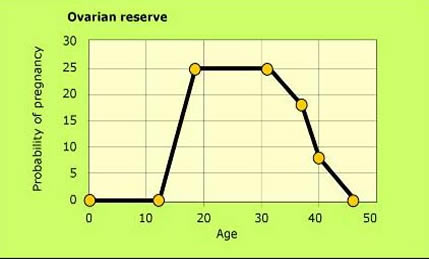Age and Fertility
Even before birth, a woman's eggs begin to diminish in number:
- During the 20th gestation week, a female embryo contains the maximum number of eggs the ovaries will ever have which is about seven million eggs.
- At birth, the number of eggs has already dropped to about 400,000. The number of eggs continues to decline as the woman ages.
- However, at the age of 37 the rate of decline is more rapid, as the rate of loss is higher than before 37, until no eggs remain (menopause).

Fortunately, women are naturally equipped with an ample supply of extra eggs. The number of eggs a woman has at birth far exceeds the average number of menstrual cycles she will have during her lifetime, that is about 400. Therefore, when women undergo fertility treatment to boost egg production, the risk for premature menopause is no different than it would be for other women.
Since a woman's chronological age is the single most important factor in predicting a couple's reproductive potential, age has often guided infertility treatment choices. However, age alone doesn't tell the whole story, as women are different with their ovarian reserve even if they are of the same age. Determining ovarian reserve depend on measuring AMH (which is the most accurate way available) read more as well as ovarian morphological assessment using transvaginal ultrasonography.

A large percentage of our practice is devoted to helping women who have a decreased egg reserve. Many of these people have been told by other centers that their eggs are no longer good. We are very willing to take accept these patients into our program. Additionally, we have data to show that we have a reasonably good pregnancy rate in poor ovarian reserve women. At the Ganin Fertility Center we have even gone so far as achieving pregnancies in women who were told they were actually in overt menopause. We have been able to do certain hormonal manipulations that can restore the sensitivity of the few remaining follicles that are left and are able to get eggs and even pregnancies. As we do not have a donor program in our center we would do all the possible manipulations with ovarian stimulation protocols to achieve our targets.

